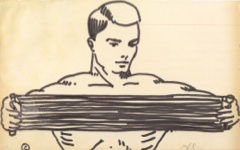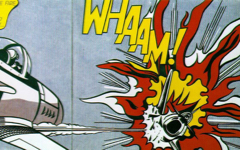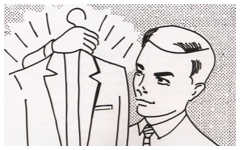Lichtenstein’s Hand Loading Gun (1961)
Guns featured in paintings by Roy Lichtenstein long before he turned towards Pop. His early paintings of American history featured weapons as well because he clearly knew then what few even today know: that artists have long used weapons to symbolize paintbrushes and other tools in art.

Lichtenstein, Hand Loading Gun (1961) Pochoir, brush and india ink. Private Collection.
Click image to enlarge.
As far back as the fifteenth century, as has only ever been shown on this site, arrows were used to symbolize St. Sebastian as the iconic self-referential artist painted by arrows. Later, more advanced weapons including rifles and guns were used by Goya, Delacroix, Manet and others for a similar purpose. You can see many examples under the theme Brushes as Swords and Weapons.
Click next thumbnail to continue
Lichtenstein's source was a small yellow diagram within an advertisement (far left) for a Daisy BB Gun, often advertised in magazines for young boys. The rifle's name "Spittin' Image" surely attracted his attention as well. He drew two versions, with the direction of the weapon inverted. In the drawing under discussion he also extended the barrel.
Click next thumbnail to continue
What no-one has seen is that the handle resembles the R of his first name Roy and that, by extending the barrel, he added the shape of an L for Lichtenstein. The gun's two-way cocking action also suggests that art's self-referential theme is a two-way street, with the painter as both artist and model, looking in and looking out. In a later more aggressive composition, Lichtenstein's felt banner Pistol, the gun is aimed straight at the viewer to convey the same idea: that the artist is "painting" himself.
Click next thumbnail to continue

Top L: Diagram of Lichtenstein's Hand Loading Gun
Bottom R: Detail of a photo of the artist (unknown photographer)
Bottom L and R: Diagrams of the images above to indicate the shape of his face in the shirt sleeve.
Click image to enlarge.
In a very subtle addition Lichtenstein shaped the arm's rolled-up sleeve into the caricatural shape of his own face. You can see his broad, prominent chin, his bulging jawline above and his high forehead. I would not show this if there were not hundreds of similarly subtle examples by earlier artists.1 Lichtenstein had obviously seen them too. So, out of the right side of his "head" emerges the artist's arm, hand and trigger-finger, the very symbols of his craft.
Click next thumbnail to continue
More Works by Lichtenstein
Notes:
1. See Leonardo's Hidden Faces, Rubens' Forest Path, Rembrandt's Landscape with a Stone Bridge and Lichtenstein's Alka-Seltzer. There are many more examples on the site under Veiled Faces and many more to be added.
Original Publication Date on EPPH: 24 Jan 2013. | Updated: 0. © Simon Abrahams. Articles on this site are the copyright of Simon Abrahams. To use copyrighted material in print or other media for purposes beyond 'fair use', you must obtain permission from the copyright owner. Websites may link to this page without permission (please do) but may not reproduce the material on their own site without crediting Simon Abrahams and EPPH.






